|
Asleep in Luxury
by
Bob Brooke
As the Industrial Revolution progressed
through the 19th century, furniture makers looked for ways to cut the
cost of producing their wares. As more expensive pieces got more
elaborate with the decorative carvings of the Renaissance Revival style,
the pieces became ever more expensive and luxurious.
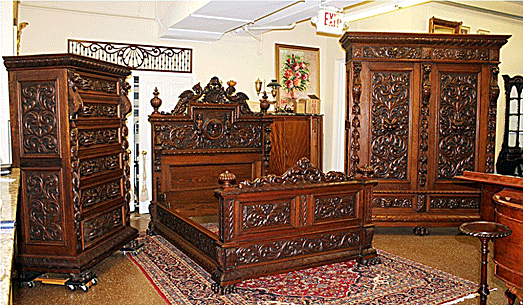
Up until the 1850s or so, people bought furniture piece meal, one piece
at a time. Because handmade furniture was expensive to make and sell,
pieces often performed more than one function. But as mass production
took hold, furniture manufacturers discovered ways to cut costs by
producing more pieces of one design or style.
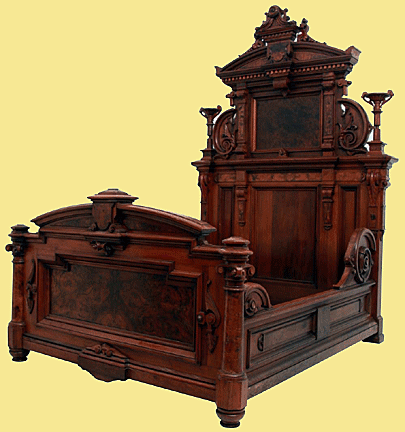 While
the idea of purchasing a set of furniture didn’t really catch on until
the 1890s, it was novel a decade earlier. Not everyone could afford to
live in a big mansion with high ceilings, so furniture makers created
smaller scale versions that were ideal for middle class homes and
Victorian cottages. While
the idea of purchasing a set of furniture didn’t really catch on until
the 1890s, it was novel a decade earlier. Not everyone could afford to
live in a big mansion with high ceilings, so furniture makers created
smaller scale versions that were ideal for middle class homes and
Victorian cottages.
At first they only offered what was known as a “bedchamber suite,” a
more formal version of bedroom suite, consisting of just two pieces—a
bed, commonly referred to as a “bedstead” and a dressing case, what most
people call a dresser. Both came in all shapes and sizes and in one of
seven different major revival styles.
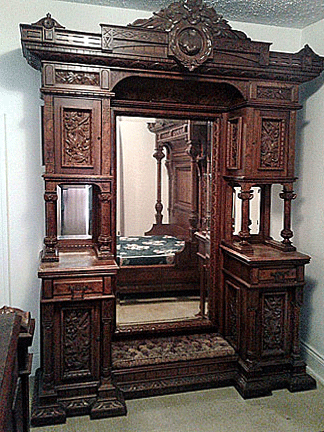 Wealthy
Americans preferred the massive Renaissance Revival style which showed
off their wealth. Not only did the size show off the wealth of the
suite’s owners, it also fit the enormous rooms with 12-foot high
ceilings common in Victorian Italianate mansions of the time. Wealthy
Americans preferred the massive Renaissance Revival style which showed
off their wealth. Not only did the size show off the wealth of the
suite’s owners, it also fit the enormous rooms with 12-foot high
ceilings common in Victorian Italianate mansions of the time.
Later on, a second type of suite appeared, one with a bedstead,
washstand, and bureau. These were smaller in scale and less ornate and
expensive than their bigger cousins.
Originally washstands consisted of a top with one drawer, towel bar
ends, and bottom shelf for storing a wash bowl and pitcher. A commode
washstand, commonly referred to as just a commode, was more dignified
and decorative. It offered various combinations of drawers and doors,
with storage shelves inside. Carved handles and applied decorations,
moldings, burl veneer panels, and gently curving back rails lent these
commodes a personality of their own. Some had ebony and gilt pulls, now
called teardrops. The brass back plates on them can be cleaned, but the
black wooden drop
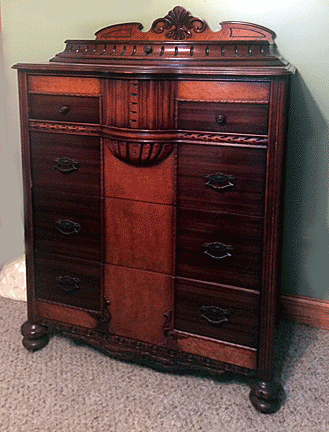 should
be untouched to emulate ebony. Small shelves on the splash back held the
soap dish or an oil lamp or a candle. should
be untouched to emulate ebony. Small shelves on the splash back held the
soap dish or an oil lamp or a candle.
To the French, a bureau is a desk, but in the United States, a bureau is
a chest of drawers. An ash bedroom suite that included a bed, bureau,
and matching washstand was offered at the low price of $20.00, providing
it was "in white, no marble, no pulls and no plate. "That's like buying
a car with no air conditioning, no heater, no radio, and no extras. "In
white" meant unfinished, and "no plate" indicated that there was no
mirror included. If you splurged and spent an extra dollar, you could
buy the set "in white with marble and pulls. No plate." A "plate" cost
$1.75, with an added charge of $2.00 to apply the finish to the frame.
When the whole suite was "finished Complete," it cost $27.00 dollars. To
a worker who labored for a few dollars a week, the set was expensive.
The options that helped reduce the expense must have seemed attractive.
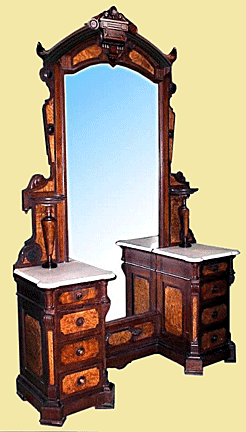 Suites
with dressing cases from the Victorian period were more expensive than
the bureau type, and more elegant as well. Sometimes their tall mirrors
seemed to extend from floor to ceiling and had ornately carved frames
that featured small bracket shelves for candle-holders or small lamps.
Drawers varied in number and size. What people now describe as a well or
step-down generally separated the parallel series of drawers.
Cabinetmakers treated all three levels alike, topping them with either
wood or marble. Some pieces had full-width drawers at the bottom of the
well. Sometimes, the mid-section below the looking glass reached down to
the floor, but this wasn’t common. To achieve individuality, customers
could order their own mirror frame, and select from 16 different carved
drawer pulls. Suites
with dressing cases from the Victorian period were more expensive than
the bureau type, and more elegant as well. Sometimes their tall mirrors
seemed to extend from floor to ceiling and had ornately carved frames
that featured small bracket shelves for candle-holders or small lamps.
Drawers varied in number and size. What people now describe as a well or
step-down generally separated the parallel series of drawers.
Cabinetmakers treated all three levels alike, topping them with either
wood or marble. Some pieces had full-width drawers at the bottom of the
well. Sometimes, the mid-section below the looking glass reached down to
the floor, but this wasn’t common. To achieve individuality, customers
could order their own mirror frame, and select from 16 different carved
drawer pulls.
In the 19th century, the word "toilet" referred to personal grooming,
thus a mirror became a toilet or plate. An oval "plate" is now called a
wishbone mirror, since the frame in which it is suspended is shaped
roughly like a fowl's wishbone.
During the 1870s, people referred to the two small drawers that sit
across from each other on the top of a bureau as decks. Today, they’ve
become known as handkerchief boxes. Much less common were the petite
boxes with hinged lift lids that sat on top of the dresser.
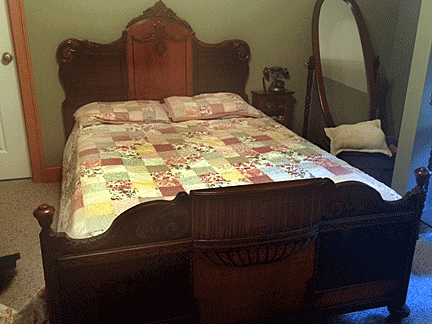 A
projection front refers to the part of a dresser that hangs out over the
base. A drawer or two may project or overhang the others. Slipper
drawers had no handles and appeared to be the apron on a dresser. Not
surprisingly, owners stored their slippers in them. Some dressers even
had hidden compartments for jewelry. A
projection front refers to the part of a dresser that hangs out over the
base. A drawer or two may project or overhang the others. Slipper
drawers had no handles and appeared to be the apron on a dresser. Not
surprisingly, owners stored their slippers in them. Some dressers even
had hidden compartments for jewelry.
Most bedroom suites came with a three-quarter size bed, but double ones
were common also. By the 1890s, bedroom suites came with seven pieces—a
bed, dresser, washstand, straight chair, rocking chair for nursing
mothers, a nightstand/commode, and an armoir or wardrobe.
Victorian Cottage Furniture
Cottage furniture became popular in the United
States, particularly along the East Coast, after the Civil War. Pieces
began appearing in workshops and then homes of the wealthy in places
like Martha's Vineyard, Cape May, and the Berkshires. But the popularity
of these items didn’t remain exclusively with the upper class. As the
middle class grew, equally elegant, but relatively reasonably priced
versions began to appear in the homes of the nation’s growing work
force, particularly in Pennsylvania and New England.
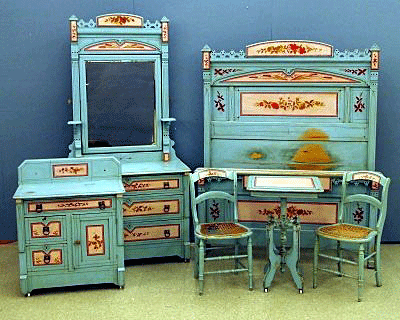 Homeowners
purchased Victorian Cottage furniture in mostly bedroom "suites", sold
as coordinating groupings consisting of a double bed, a washstand, a
dresser or vanity with an attached mirror, a small table, a straight
chair and a rocker, and often a wardrobe. Cabinetmakers used pine or
other inexpensive wood, then painted the entire piece with several
layers of paint. The finished sets were colorful and whimsical. But not
all sets were painted. Homeowners
purchased Victorian Cottage furniture in mostly bedroom "suites", sold
as coordinating groupings consisting of a double bed, a washstand, a
dresser or vanity with an attached mirror, a small table, a straight
chair and a rocker, and often a wardrobe. Cabinetmakers used pine or
other inexpensive wood, then painted the entire piece with several
layers of paint. The finished sets were colorful and whimsical. But not
all sets were painted.
Cottage Victorian beds have high, decorated headboards, some as high as
six feet. Finials and medallions constituted what little carving there
was on most pieces. Most of the
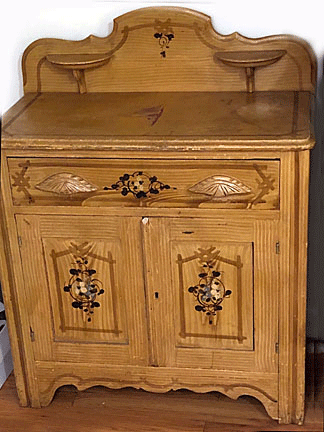 decoration
took the form of painted flowers, fruit, and other plants, featuring a
large painted bouquet-like medallion in a central panel on the headboard
and a smaller, matching one on the foot-board. decoration
took the form of painted flowers, fruit, and other plants, featuring a
large painted bouquet-like medallion in a central panel on the headboard
and a smaller, matching one on the foot-board.
Originally, local cabinetmakers, most of whom didn’t have any formal
training, built these pieces from designs in pattern books, but towards
the last two decades of the 19th century, manufacturers began to mass
produce them.
Manufacturers produced sets like this one as cheaply as possible. Made
usually of pine with machine turned legs and finials, they featured as
little structural decoration as possible. Even painted motifs were kept
to a minimum to reduce the time it took to do them. Some even feature
stenciled designs, so that the maker didn’t have to pay more for trained
artists.
<
Back to Antiques Archives
Next Article > |
